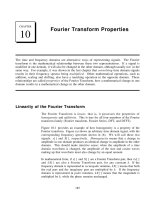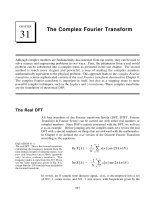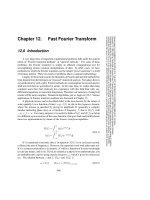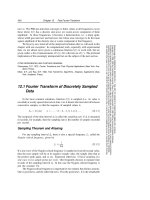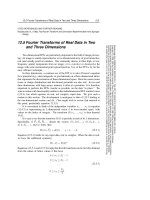The Discrete Fourier Transform
Bạn đang xem bản rút gọn của tài liệu. Xem và tải ngay bản đầy đủ của tài liệu tại đây (475.54 KB, 28 trang )
141
CHAPTER
8
The Discrete Fourier Transform
Fourier analysis is a family of mathematical techniques, all based on decomposing signals into
sinusoids. The discrete Fourier transform (DFT) is the family member used with digitized
signals. This is the first of four chapters on the real DFT, a version of the discrete Fourier
transform that uses real numbers to represent the input and output signals. The complex DFT,
a more advanced technique that uses complex numbers, will be discussed in Chapter 31. In this
chapter we look at the mathematics and algorithms of the Fourier decomposition, the heart of the
DFT.
The Family of Fourier Transform
Fourier analysis is named after Jean Baptiste Joseph Fourier (1768-1830),
a French mathematician and physicist. (Fourier is pronounced: , and isfor@¯e@¯a
always capitalized). While many contributed to the field, Fourier is honored
for his mathematical discoveries and insight into the practical usefulness of the
techniques. Fourier was interested in heat propagation, and presented a paper
in 1807 to the Institut de France on the use of sinusoids to represent
temperature distributions. The paper contained the controversial claim that any
continuous periodic signal could be represented as the sum of properly chosen
sinusoidal waves. Among the reviewers were two of history's most famous
mathematicians, Joseph Louis Lagrange (1736-1813), and Pierre Simon de
Laplace (1749-1827).
While Laplace and the other reviewers voted to publish the paper, Lagrange
adamantly protested. For nearly 50 years, Lagrange had insisted that such an
approach could not be used to represent signals with corners, i.e.,
discontinuous slopes, such as in square waves. The Institut de France bowed
to the prestige of Lagrange, and rejected Fourier's work. It was only after
Lagrange died that the paper was finally published, some 15 years later.
Luckily, Fourier had other things to keep him busy, political activities,
expeditions to Egypt with Napoleon, and trying to avoid the guillotine after the
French Revolution (literally!).
The Scientist and Engineer's Guide to Digital Signal Processing142
Sample number
0 4 8 12 16
-40
-20
0
20
40
60
80
DECOMPOSE
SYNTHESIZE
FIGURE 8-1a
(see facing page)
Amplitude
Who was right? It's a split decision. Lagrange was correct in his assertion that
a summation of sinusoids cannot form a signal with a corner. However, you
can get very close. So close that the difference between the two has zero
energy. In this sense, Fourier was right, although 18th century science knew
little about the concept of energy. This phenomenon now goes by the name:
Gibbs Effect, and will be discussed in Chapter 11.
Figure 8-1 illustrates how a signal can be decomposed into sine and cosine
waves. Figure (a) shows an example signal, 16 points long, running from
sample number 0 to 15. Figure (b) shows the Fourier decomposition of this
signal, nine cosine waves and nine sine waves, each with a different
frequency and amplitude. Although far from obvious, these 18 sinusoids
add to produce the waveform in (a). It should be noted that the objection
made by Lagrange only applies to continuous signals. For discrete signals,
this decomposition is mathematically exact. There is no difference between the
signal in (a) and the sum of the signals in (b), just as there is no difference
between 7 and 3+4.
Why are sinusoids used instead of, for instance, square or triangular waves?
Remember, there are an infinite number of ways that a signal can be
decomposed. The goal of decomposition is to end up with something easier to
deal with than the original signal. For example, impulse decomposition allows
signals to be examined one point at a time, leading to the powerful technique
of convolution. The component sine and cosine waves are simpler than the
original signal because they have a property that the original signal does not
have: sinusoidal fidelity. As discussed in Chapter 5, a sinusoidal input to a
system is guaranteed to produce a sinusoidal output. Only the amplitude and
phase of the signal can change; the frequency and wave shape must remain the
same. Sinusoids are the only waveform that have this useful property. While
square and triangular decompositions are possible, there is no general reason
for them to be useful.
The general term: Fourier transform, can be broken into four categories,
resulting from the four basic types of signals that can be encountered.
Chapter 8- The Discrete Fourier Transform 143
0 2 4 6 8 10 12 14 16
-8
-4
0
4
8
0 2 4 6 8 10 12 14 16
-8
-4
0
4
8
0 2 4 6 8 10 12 14 16
-8
-4
0
4
8
0 2 4 6 8 10 12 14 16
-8
-4
0
4
8
0 2 4 6 8 10 12 14 16
-8
-4
0
4
8
0 2 4 6 8 10 12 14 16
-8
-4
0
4
8
0 2 4 6 8 10 12 14 16
-8
-4
0
4
8
0 2 4 6 8 10 12 14 16
-8
-4
0
4
8
0 2 4 6 8 10 12 14 16
-8
-4
0
4
8
0 2 4 6 8 10 12 14 16
-8
-4
0
4
8
0 2 4 6 8 10 12 14 16
-8
-4
0
4
8
0 2 4 6 8 10 12 14 16
-8
-4
0
4
8
0 2 4 6 8 10 12 14 16
-8
-4
0
4
8
0 2 4 6 8 10 12 14 16
-8
-4
0
4
8
0 2 4 6 8 10 12 14 16
-8
-4
0
4
8
0 2 4 6 8 10 12 14 16
-8
-4
0
4
8
0 2 4 6 8 10 12 14 16
-8
-4
0
4
8
0 2 4 6 8 10 12 14 16
-8
-4
0
4
8
Cosine Waves
Sine Waves
FIGURE 8-1b
Example of Fourier decomposition. A 16 point signal (opposite page) is decomposed into 9 cosine
waves and 9 sine waves. The frequency of each sinusoid is fixed; only the amplitude is changed
depending on the shape of the waveform being decomposed.
The Scientist and Engineer's Guide to Digital Signal Processing144
A signal can be either continuous or discrete, and it can be either periodic or
aperiodic. The combination of these two features generates the four categories,
described below and illustrated in Fig. 8-2.
Aperiodic-Continuous
This includes, for example, decaying exponentials and the Gaussian curve.
These signals extend to both positive and negative infinity without repeating in
a periodic pattern. The Fourier Transform for this type of signal is simply
called the Fourier Transform.
Periodic-Continuous
Here the examples include: sine waves, square waves, and any waveform that
repeats itself in a regular pattern from negative to positive infinity. This
version of the Fourier transform is called the Fourier Series.
Aperiodic-Discrete
These signals are only defined at discrete points between positive and negative
infinity, and do not repeat themselves in a periodic fashion. This type of
Fourier transform is called the Discrete Time Fourier Transform.
Periodic-Discrete
These are discrete signals that repeat themselves in a periodic fashion from
negative to positive infinity. This class of Fourier Transform is sometimes
called the Discrete Fourier Series, but is most often called the Discrete
Fourier Transform.
You might be thinking that the names given to these four types of Fourier
transforms are confusing and poorly organized. You're right; the names have
evolved rather haphazardly over 200 years. There is nothing you can do but
memorize them and move on.
These four classes of signals all extend to positive and negative infinity. Hold
on, you say! What if you only have a finite number of samples stored in your
computer, say a signal formed from 1024 points. Isn't there a version of the
Fourier Transform that uses finite length signals? No, there isn't. Sine and
cosine waves are defined as extending from negative infinity to positive
infinity. You cannot use a group of infinitely long signals to synthesize
something finite in length. The way around this dilemma is to make the finite
data look like an infinite length signal. This is done by imagining that the
signal has an infinite number of samples on the left and right of the actual
points. If all these “imagined” samples have a value of zero, the signal looks
discrete and aperiodic, and the Discrete Time Fourier Transform applies. As
an alternative, the imagined samples can be a duplication of the actual 1024
points. In this case, the signal looks discrete and periodic, with a period of
1024 samples. This calls for the Discrete Fourier Transform to be used.
As it turns out, an infinite number of sinusoids are required to synthesize a
signal that is aperiodic. This makes it impossible to calculate the Discrete
Time Fourier Transform in a computer algorithm. By elimination, the only
Chapter 8- The Discrete Fourier Transform 145
Type of Transform Example Signal
Fourier Transform
Fourier Series
Discrete Time Fourier Transform
Discrete Fourier Transform
signals that are continious and aperiodic
signals that are continious and periodic
signals that are discrete and aperiodic
signals that are discrete and periodic
FIGURE 8-2
Illustration of the four Fourier transforms. A signal may be continuous or discrete, and it may be
periodic or aperiodic. Together these define four possible combinations, each having its own version
of the Fourier transform. The names are not well organized; simply memorize them.
type of Fourier transform that can be used in DSP is the DFT. In other words,
digital computers can only work with information that is discrete and finite in
length. When you struggle with theoretical issues, grapple with homework
problems, and ponder mathematical mysteries, you may find yourself using the
first three members of the Fourier transform family. When you sit down to
your computer, you will only use the DFT. We will briefly look at these other
Fourier transforms in future chapters. For now, concentrate on understanding
the Discrete Fourier Transform.
Look back at the example DFT decomposition in Fig. 8-1. On the face of it,
it appears to be a 16 point signal being decomposed into 18 sinusoids, each
consisting of 16 points. In more formal terms, the 16 point signal, shown in
(a), must be viewed as a single period of an infinitely long periodic signal.
Likewise, each of the 18 sinusoids, shown in (b), represents a 16 point segment
from an infinitely long sinusoid. Does it really matter if we view this as a 16
point signal being synthesized from 16 point sinusoids, or as an infinitely long
periodic signal being synthesized from infinitely long sinusoids? The answer
is: usually no, but sometimes, yes. In upcoming chapters we will encounter
properties of the DFT that seem baffling if the signals are viewed as finite, but
become obvious when the periodic nature is considered. The key point to
understand is that this periodicity is invoked in order to use a mathematical
tool, i.e., the DFT. It is usually meaningless in terms of where the signal
originated or how it was acquired.
The Scientist and Engineer's Guide to Digital Signal Processing146
Each of the four Fourier Transforms can be subdivided into real and
complex versions. The real version is the simplest, using ordinary numbers
and algebra for the synthesis and decomposition. For instance, Fig. 8-1 is
an example of the real DFT. The complex versions of the four Fourier
transforms are immensely more complicated, requiring the use of complex
numbers. These are numbers such as: , where j is equal to 3 %4j
&1
(electrical engineers use the variable j, while mathematicians use the
variable, i). Complex mathematics can quickly become overwhelming, even
to those that specialize in DSP. In fact, a primary goal of this book is to
present the fundamentals of DSP without the use of complex math, allowing
the material to be understood by a wider range of scientists and engineers.
The complex Fourier transforms are the realm of those that specialize in
DSP, and are willing to sink to their necks in the swamp of mathematics.
If you are so inclined, Chapters 30-33 will take you there.
The mathematical term: transform, is extensively used in Digital Signal
Processing, such as: Fourier transform, Laplace transform, Z transform,
Hilbert transform, Discrete Cosine transform, etc. Just what is a transform?
To answer this question, remember what a function is. A function is an
algorithm or procedure that changes one value into another value. For
example, is a function. You pick some value for x, plug it into they ' 2x %1
equation, and out pops a value for y. Functions can also change several
values into a single value, such as: , where and c arey ' 2a % 3b % 4c a, b,
changed into y.
Transforms are a direct extension of this, allowing both the input and output to
have multiple values. Suppose you have a signal composed of 100 samples.
If you devise some equation, algorithm, or procedure for changing these 100
samples into another 100 samples, you have yourself a transform. If you think
it is useful enough, you have the perfect right to attach your last name to it and
expound its merits to your colleagues. (This works best if you are an eminent
18th century French mathematician). Transforms are not limited to any specific
type or number of data. For example, you might have 100 samples of discrete
data for the input and 200 samples of discrete data for the output. Likewise,
you might have a continuous signal for the input and a continuous signal for the
output. Mixed signals are also allowed, discrete in and continuous out, and
vice versa. In short, a transform is any fixed procedure that changes one chunk
of data into another chunk of data. Let's see how this applies to the topic at
hand: the Discrete Fourier transform.
Notation and Format of the Real DFT
As shown in Fig. 8-3, the discrete Fourier transform changes an N point input
signal into two point output signals. The input signal contains theN/2 %1
signal being decomposed, while the two output signals contain the amplitudes
of the component sine and cosine waves (scaled in a way we will discuss
shortly). The input signal is said to be in the time domain. This is because
the most common type of signal entering the DFT is composed of
Chapter 8- The Discrete Fourier Transform 147
Time Domain
Frequency Domain
x[ ] Re X[ ]
Im X[ ]
0
N-1
0 N/2
0 N/2
Forward DFT
Inverse DFT
N/2+1 samples
(cosine wave amplitudes)
N/2+1 samples
(sine wave amplitudes)
collectively referred to as X[ ]
N samples
FIGURE 8-3
DFT terminology. In the time domain, consists of N points running from 0 to . In the frequency domain,
x[ ]
N&1
the DFT produces two signals, the real part, written: , and the imaginary part, written: . Each ofReX[ ] Im X[ ]
these frequency domain signals are points long, and run from 0 to . The Forward DFT transforms fromN/2 %1 N/2
the time domain to the frequency domain, while the Inverse DFT transforms from the frequency domain to the
time domain. (Take note: this figure describes the real DFT. The complex DFT, discussed in Chapter 31,
changes N complex points into another set of N complex points).
samples taken at regular intervals of time. Of course, any kind of sampled
data can be fed into the DFT, regardless of how it was acquired. When you
see the term "time domain" in Fourier analysis, it may actually refer to
samples taken over time, or it might be a general reference to any discrete
signal that is being decomposed. The term frequency domain is used to
describe the amplitudes of the sine and cosine waves (including the special
scaling we promised to explain).
The frequency domain contains exactly the same information as the time
domain, just in a different form. If you know one domain, you can calculate
the other. Given the time domain signal, the process of calculating the
frequency domain is called decomposition, analysis, the forward DFT, or
simply, the DFT. If you know the frequency domain, calculation of the time
domain is called synthesis, or the inverse DFT. Both synthesis and analysis
can be represented in equation form and computer algorithms.
The number of samples in the time domain is usually represented by the
variable N. While N can be any positive integer, a power of two is usually
chosen, i.e., 128, 256, 512, 1024, etc. There are two reasons for this. First,
digital data storage uses binary addressing, making powers of two a natural
signal length. Second, the most efficient algorithm for calculating the DFT, the
Fast Fourier Transform (FFT), usually operates with N that is a power of two.
Typically, N is selected between 32 and 4096. In most cases, the samples run
from 0 to , rather than 1 to N. N&1
Standard DSP notation uses lower case letters to represent time domain
signals, such as , , and . The corresponding upper case letters arex[ ] y[ ] z[ ]
The Scientist and Engineer's Guide to Digital Signal Processing148
used to represent their frequency domains, that is, , , and . ForX[ ] Y[ ] Z[ ]
illustration, assume an N point time domain signal is contained in . Thex[ ]
frequency domain of this signal is called , and consists of two parts, eachX[ ]
an array of samples. These are called the Real part of , writtenN/2 %1
X[ ]
as: , and the Imaginary part of , written as: . The values
Re X[ ] X[ ] Im X[ ]
in are the amplitudes of the cosine waves, while the values in Re X[ ] Im X[ ]
are the amplitudes of the sine waves (not worrying about the scaling factors for
the moment). Just as the time domain runs from to , the frequencyx[0] x[N&1]
domain signals run from to , and from to .ReX[0] ReX[N/2] ImX[0] Im X[N/2]
Study these notations carefully; they are critical to understanding the equations
in DSP. Unfortunately, some computer languages don't distinguish between
lower and upper case, making the variable names up to the individual
programmer. The programs in this book use the array XX[ ] to hold the time
domain signal, and the arrays REX[ ] and IMX[ ] to hold the frequency domain
signals.
The names real part and imaginary part originate from the complex DFT,
where they are used to distinguish between real and imaginary numbers.
Nothing so complicated is required for the real DFT. Until you get to Chapter
31, simply think that "real part" means the cosine wave amplitudes, while
"imaginary part" means the sine wave amplitudes. Don't let these suggestive
names mislead you; everything here uses ordinary numbers.
Likewise, don't be misled by the lengths of the frequency domain signals. It
is common in the DSP literature to see statements such as: "The DFT changes
an N point time domain signal into an N point frequency domain signal." This
is referring to the complex DFT, where each "point" is a complex number
(consisting of real and imaginary parts). For now, focus on learning the real
DFT, the difficult math will come soon enough.
The Frequency Domain's Independent Variable
Figure 8-4 shows an example DFT with . The time domain signal isN ' 128
contained in the array: to . The frequency domain signals arex[0] x[127]
contained in the two arrays: to , and to .ReX[0] ReX[64] Im X[0] Im X[64]
Notice that 128 points in the time domain corresponds to 65 points in each of
the frequency domain signals, with the frequency indexes running from 0 to 64.
That is, N points in the time domain corresponds to points in theN/2 %1
frequency domain (not points). Forgetting about this extra point is aN/2
common bug in DFT programs.
The horizontal axis of the frequency domain can be referred to in four
different ways, all of which are common in DSP. In the first method, the
horizontal axis is labeled from 0 to 64, corresponding to the 0 to N/2
samples in the arrays. When this labeling is used, the index for the
frequency domain is an integer, for example, and , where kRe X[k] Im X[k]
runs from 0 to in steps of one. Programmers like this method becauseN/2
it is how they write code, using an index to access array locations. This
notation is used in Fig. 8-4b.
Chapter 8- The Discrete Fourier Transform 149
Sample number
0 16 32 48 64 80 96 112 128
-2
-1
0
1
2
a. x[ ]
127
Frequency (sample number)
0 16 32 48 64
-8
-4
0
4
8
b. Re X[ ]
Frequency (fraction of sampling rate)
0 0.1 0.2 0.3 0.4 0.5
-8
-4
0
4
8
c. Im X[ ]
Frequency DomainTime Domain
FIGURE 8-4
Example of the DFT. The DFT converts the
time domain signal, , into the frequencyx[ ]
domain signals, and . TheReX[ ] Im X[ ]
horizontal axis of the frequency domain can be
labeled in one of three ways: (1) as an array
index that runs between 0 and , (2) as aN/2
fraction of the sampling frequency, running
between 0 and 0.5, (3) as a natural frequency,
running between 0 and B. In the example
shown here, (b) uses the first method, while (c)
use the second method.
Amplitude Amplitude
Amplitude
In the second method, used in (c), the horizontal axis is labeled as a fraction
of the sampling rate. This means that the values along the horizonal axis
always run between 0 and 0.5, since discrete data can only contain frequencies
between DC and one-half the sampling rate. The index used with this notation
is f, for frequency. The real and imaginary parts are written: andReX [f ]
, where takes on equally spaced values between 0 and 0.5.ImX [f ] f N/2 %1
To convert from the first notation, k, to the second notation, , divide thef
horizontal axis by N. That is, . Most of the graphs in this book use thisf ' k/N
second method, reinforcing that discrete signals only contain frequencies
between 0 and 0.5 of the sampling rate.
The third style is similar to the second, except the horizontal axis is
multiplied by 2B. The index used with this labeling is T, a lower case
Greek omega. In this notation, the real and imaginary parts are written:
and , where T takes on equally spaced valuesReX [ T] ImX [ T] N/2 %1
between 0 and B. The parameter, T, is called the natural frequency, and
has the units of radians. This is based on the idea that there are 2B radians
in a circle. Mathematicians like this method because it makes the equations
shorter. For instance, consider how a cosine wave is written in each of
these first three notations: using k: , using :c[n] ' cos(2B kn/N) f
, and using T: . c[n] ' cos(2B fn) c[n] ' cos(T n)
The Scientist and Engineer's Guide to Digital Signal Processing150
c
k
[i] ' cos(2B ki/N)
EQUATION 8-1
Equations for the DFT basis functions. In
these equations, and are thec
k
[i] s
k
[i]
cosine and sine waves, each N points in
length, running from to . Thei ' 0 N&1
parameter, k, determines the frequency of
the wave. In an N point DFT, k takes on
values between 0 and .N/2
s
k
[i] ' sin (2B ki/N)
The fourth method is to label the horizontal axis in terms of the analog
frequencies used in a particular application. For instance, if the system being
examined has a sampling rate of 10 kHz (i.e., 10,000 samples per second),
graphs of the frequency domain would run from 0 to 5 kHz. This method has
the advantage of presenting the frequency data in terms of a real world
meaning. The disadvantage is that it is tied to a particular sampling rate, and
is therefore not applicable to general DSP algorithm development, such as
designing digital filters.
All of these four notations are used in DSP, and you need to become
comfortable with converting between them. This includes both graphs and
mathematical equations. To find which notation is being used, look at the
independent variable and its range of values. You should find one of four
notations: k (or some other integer index), running from 0 to ; f, runningN/2
from 0 to 0.5; T, running from 0 to B; or a frequency expressed in hertz,
running from DC to one-half of an actual sampling rate.
DFT Basis Functions
The sine and cosine waves used in the DFT are commonly called the DFT
basis functions. In other words, the output of the DFT is a set of numbers
that represent amplitudes. The basis functions are a set of sine and cosine
waves with unity amplitude. If you assign each amplitude (the frequency
domain) to the proper sine or cosine wave (the basis functions), the result
is a set of scaled sine and cosine waves that can be added to form the time
domain signal.
The DFT basis functions are generated from the equations:
where: is the cosine wave for the amplitude held in , and isc
k
[ ] ReX[k] s
k
[ ]
the sine wave for the amplitude held in . For example, Fig. 8-5 showsIm X[k]
some of the 17 sine and 17 cosine waves used in an point DFT. SinceN ' 32
these sinusoids add to form the input signal, they must be the same length as
the input signal. In this case, each has 32 points running from to 31. Thei ' 0
parameter, k, sets the frequency of each sinusoid. In particular, is thec
1
[ ]
cosine wave that makes one complete cycle in N points, is the cosinec
5
[ ]
wave that makes five complete cycles in N points, etc. This is an important
concept in understanding the basis functions; the frequency parameter, k, is
equal to the number of complete cycles that occur over the N points of the
signal.
Chapter 8- The Discrete Fourier Transform 151
Sample number
0 8 16 24 32
-2
-1
0
1
2
a. c
0
[ ]
Sample number
0 8 16 24 32
-2
-1
0
1
2
c. c
2
[ ]
Sample number
0 8 16 24 32
-2
-1
0
1
2
e. c
10
[ ]
Sample number
0 8 16 24 32
-2
-1
0
1
2
f. s
10
[ ]
Sample number
0 8 16 24 32
-2
-1
0
1
2
h. s
16
[ ]
Sample number
0 8 16 24 32
-2
-1
0
1
2
b. s
0
[ ]
Sample number
0 8 16 24 32
-2
-1
0
1
2
d. s
2
[ ]
Sample number
0 8 16 24 32
-2
-1
0
1
2
g. c
16
[ ]
FIGURE 8-5
DFT basis functions. A 32 point DFT has 17 discrete cosine waves and 17 discrete sine waves for
its basis functions. Eight of these are shown in this figure. These are discrete signals; the continuous
lines are shown in these graphs only to help the reader's eye follow the waveforms.
Amplitude
Amplitude
AmplitudeAmplitude
Amplitude
Amplitude
Amplitude Amplitude

